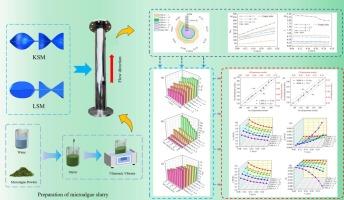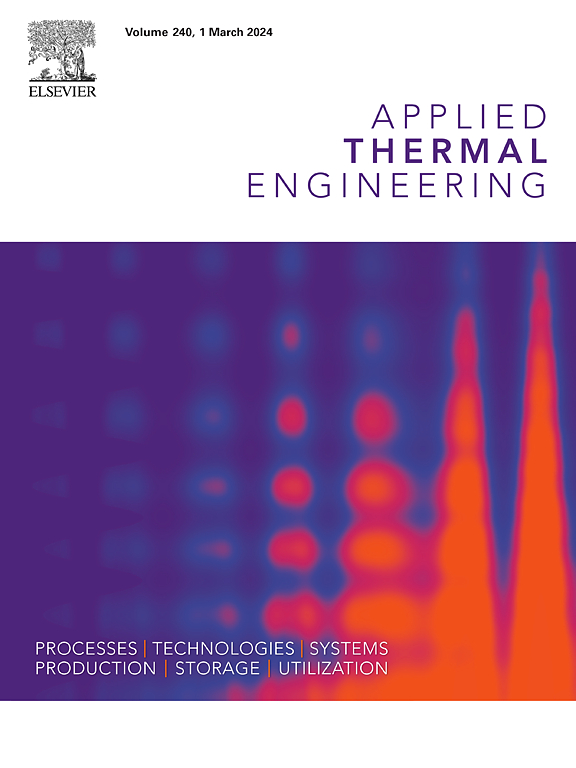Enhancing turbulent hydrothermal pretreatment of non-Newtonian microalgae slurry utilizing static mixers with secondary flow generators
IF 6.1
2区 工程技术
Q2 ENERGY & FUELS
引用次数: 0
Abstract
Hydrothermal pretreatment is an efficient process to convert microalgae slurry into biodiesel. The conversion efficiency largely depends on the heat transfer performance of microalgae slurry in various mixers. Compared with previous studies on laminar heat transfer performance of microalgae slurry in horizontal empty tubes, this study numerically investigates the turbulent heat transfer performance of microalgae slurry in vertical Lightnin static mixer and Kenics static mixer with different aspect ratios. The generalized Reynolds number is in the range of 530–5850. The effects of inlet velocity and mass fraction for microalgae slurry on the enhanced heat transfer performance of static mixers are evaluated. Results indicate the Performance evaluation criteria of Kenics static mixers with the aspect ratios of 1, 1.5, and 2 are higher than those of Lightnin static mixers by 9.32–17.81 %, 10.38–20.51 %, and 3.19–14.95 %, respectively. The empirical correlations of microalgae slurry for Nusselt number and Fanning friction coefficient are proposed. Additionally, the entropy generations of Kenics static mixer are higher than that of Lightnin static mixer by 21.34–27.37 %, 10.80–20.57 %, and 12.31–20.46 %, when the aspect ratios are 1, 1.5, and 2, respectively. Therefore, the Lightnin static mixer is recommended when the enhanced heat transfer performance is mainly considered. Additionally, 5 wt% microalgae slurry is recommended for hydrothermal pretreatment.

利用带二次流发生器的静态混合器加强对非牛顿流体微藻浆料的湍流水热预处理
水热预处理是将微藻泥浆转化为生物柴油的有效工艺。转化效率在很大程度上取决于微藻浆液在各种混合器中的传热性能。与之前关于微藻浆液在水平空管中层流传热性能的研究相比,本研究通过数值方法研究了微藻浆液在不同长径比的立式 Lightnin 静态混合器和 Kenics 静态混合器中的湍流传热性能。广义雷诺数范围为 530-5850。评估了入口速度和微藻浆质量分数对静态混合器增强传热性能的影响。结果表明,长径比为 1、1.5 和 2 的 Kenics 静态混合器的性能评估标准分别比 Lightnin 静态混合器高出 9.32-17.81%、10.38-20.51% 和 3.19-14.95%。提出了微藻浆液的努塞尔特数和范宁摩擦系数的经验相关性。此外,当长径比为 1、1.5 和 2 时,Kenics 静态混合器的熵生成分别比 Lightnin 静态混合器高 21.34-27.37%、10.80-20.57% 和 12.31-20.46%。因此,在主要考虑提高传热性能时,推荐使用 Lightnin 静态混合器。此外,建议使用 5 wt% 的微藻浆进行水热预处理。
本文章由计算机程序翻译,如有差异,请以英文原文为准。
求助全文
约1分钟内获得全文
求助全文
来源期刊

Applied Thermal Engineering
工程技术-工程:机械
CiteScore
11.30
自引率
15.60%
发文量
1474
审稿时长
57 days
期刊介绍:
Applied Thermal Engineering disseminates novel research related to the design, development and demonstration of components, devices, equipment, technologies and systems involving thermal processes for the production, storage, utilization and conservation of energy, with a focus on engineering application.
The journal publishes high-quality and high-impact Original Research Articles, Review Articles, Short Communications and Letters to the Editor on cutting-edge innovations in research, and recent advances or issues of interest to the thermal engineering community.
 求助内容:
求助内容: 应助结果提醒方式:
应助结果提醒方式:


